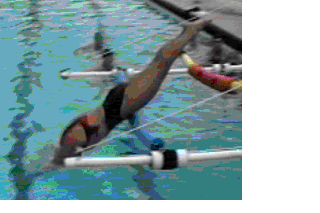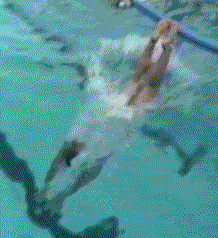

The Magic SurgeTM
Definitions
Acceleration - velocity is a vector quantity (possessing both magnitude and direction). A body traveling at constant speed may be said to be accelerating if it's direction of motion changes.
Speed - is a scalar quantity in which direction of motion is unimportant. (Unlike vector quantity, velocity in which both magnitude and direction must be taken into consideration).
Newton's second law of motion - A net force applied to a body gives it a rate of change of momentum proportional to the force and in the direction of the force.
Newton's third law of motion - To every action there is an equal and opposite reaction.
The Magic SurgeTM
This is the most important and critical part of the start. This is where the big difference in the knock-down of times is made.

The angle of entry and the change of angle after entry at this position is probably the most important factor for a powerful start and maintaining the momentum of the dive.
The splash from too big a hole will slow the momentum. (Too shallow an entry). If the angle of entry is too deep the swimmer will loose forward momentum defined by the angle of entry as down instead of forward.
The PowerStartsTM Theory
Statistical analysis indicates that the type of dive (flat vs. pike) and the starting-point height of the dive (18" high from water's surface to starting platform vs. 30" height from the water's surface to starting platform) were related to a significant effect. As the starting-point height (the height of the starting block) of each dive increases, the depth of the dive increases. Action-reaction.
When the swimmer can change the downward direction by arching the back, steering-up with hands and arms while stretching the body as long as possible and pointing the toes, this change in direction may be said to cause acceleration.
The horizontal velocity of the swimmer at the lowest point of the dive (vertical velocity is zero) was significantly greater as the height of the dive increased. "Both the starting block height and the pike dive caused a significant increase in horizontal velocity." Quote from A Report to the NCAA: Characteristics of Competitive Swimming Starts: Injury Prevention by Gale M. Gehlsen, John Wingfield, Biomechanics Laboratory, Ball State University, Muncie, IN, USA, 47306.
The feet come down and kick as they enter the water. It's okay to bend the knees a little just before entry. However, it must be times so that the legs are straightening as the body enters the water. The feet will be together and hit the surface at the same time to be effective.

Point your toes on entry and glide only long enough to take full advantage of the dive momentum.
Don't go too deep on entry. Usually when we see the feet flip over during entry it is because the angle of entry was too deep. During entry into the water, the body encounters a pressure or drag force which opposes the entry. The water is said to be elastic. This drag force always acts in the opposite direction of the diver's motion (water resistance). Drag is influenced by maximal body cross-section as well as body length.
It's preferable to arch the back in a downward motion so that the body steers-up. Arching the back aids in steering towards the surface.

Too much steering will also cause drag. In addition to drag, the diver entering the water headfirst begins to develop lift forces as soon as the hands enter the water and begin to plane against the resistance of the water. The lift forces can be generated to steer the head and body in any direction that is desired. Lift forces can also be used to rapidly change the direction of motion and cause acceleration or deceleration.